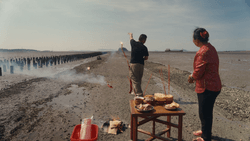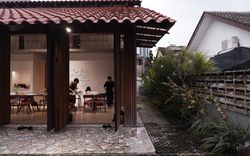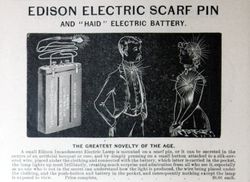textual records
ARCH276183
Description:
35 files - Group contains subject working files, project files, travel documents and professional organizations. Files are generally organized alphabetically, R-V and include: RAIC Foundation; Royal Canadian Academy of Arts; Reddy Residence; Royal Institute of British Architects; Robson Square 2008, 2010; Robson Revitalization, New Developments and Redemiation; Roy Thompson Hall; Simon Fraser University 40th Anniversary, Gymnasium and Fitness Centre, Housing, Village; St. Paul Project; Shanghai/Keller/Lee; Shanghai Office (agreement); Shimao Nanjing Project; Shunyi Xiang Xie Garden Villa; Squamish Road, Wolfgang Richter; Sustainability - Ecology; Trips 2002-2006; UBC - University Boulevard design Competition; UNA of Canada (September 2006 event); U.S. Architects Practice - Act and Licenses; Vancouver Aids Memorial; Vancouver Arts Awards 2004; Visa and Photos.
circa 2000-2005
Working files, project files, and travel documents from Erickson's office
Actions:
ARCH276183
Description:
35 files - Group contains subject working files, project files, travel documents and professional organizations. Files are generally organized alphabetically, R-V and include: RAIC Foundation; Royal Canadian Academy of Arts; Reddy Residence; Royal Institute of British Architects; Robson Square 2008, 2010; Robson Revitalization, New Developments and Redemiation; Roy Thompson Hall; Simon Fraser University 40th Anniversary, Gymnasium and Fitness Centre, Housing, Village; St. Paul Project; Shanghai/Keller/Lee; Shanghai Office (agreement); Shimao Nanjing Project; Shunyi Xiang Xie Garden Villa; Squamish Road, Wolfgang Richter; Sustainability - Ecology; Trips 2002-2006; UBC - University Boulevard design Competition; UNA of Canada (September 2006 event); U.S. Architects Practice - Act and Licenses; Vancouver Aids Memorial; Vancouver Arts Awards 2004; Visa and Photos.
textual records
circa 2000-2005
To Build Law
To Build Law is the second chapter of Groundwork, a three-part film and exhibition series exploring the conceptual development and field research of contemporary architects cultivating alternative modes of practice.
Berlin, HouseEurope!, bplus, Arno Brandlhuber, Francesco Garutti, To Build Law, groundwork, ecology
2024
To Build Law
Actions:
Description:
To Build Law is the second chapter of Groundwork, a three-part film and exhibition series exploring the conceptual development and field research of contemporary architects cultivating alternative modes of practice.
Berlin, HouseEurope!, bplus, Arno Brandlhuber, Francesco Garutti, To Build Law, groundwork, ecology
articles
Placekeeping
sustainability, indigenous, colonialism, indigeneity, reindigenize, sisterhood, sorority, ecology, food, reciprocity, land-based practices
30 March 2025
Placekeeping
Brooke Rice, Autumn Godwin, Marnie Jacobs, and Amanda Lickers reflect on acts of reciprocity and land-based knowledge teachings
Actions:
events
Learning from... London
Kieran Long presents a story about the difficulty of describing a city in all its richness. London contains stories and meanings that are alive to its citizens, but apparently too difficult to talk about, too rich, and too messy to be allowed to affect those who decide how the city changes. The deafness of developers, politicians and architects to these narratives is so(...)
Paul Desmarais Theater
10 March 2011 , 7pm
Learning from... London
Actions:
Description:
Kieran Long presents a story about the difficulty of describing a city in all its richness. London contains stories and meanings that are alive to its citizens, but apparently too difficult to talk about, too rich, and too messy to be allowed to affect those who decide how the city changes. The deafness of developers, politicians and architects to these narratives is so(...)
events
10 March 2011
7pm
Paul Desmarais Theater
Series
AP193.S1
Description:
Series 1, Water Flux and Scrambled Flat, 2002-2010, documents the conception and evolution of a project that was originally a farm building and later became a geology and glaciology museum and research center focused on the Swiss Alps. The project was never realized. R&Sie(n) conceptualized Scrambled Flat as an experimental farm. The project goal was to reconcile European Union’s agricultural regulations, imposing a separation between animal and human living, to the community of Évolène traditional way of living, contiguously with animals, benefiting from the resources they offer. As conceived, Scrambled Flat creates an environment where fluidity between the existence of the animals and the humans is materialized. The size of the form is also adapted from a typical local rural house and exploits the heat of the animals and the insulation of the hay. For this project, R&Sie(n) approached the mayor of the community with the design proposition. The mayor then called for a competition, while also changing the program to an ecology museum and research center illustrating the local effects of global warming and the thawing of the Alps. R&Sie(n) won the competition with Water Flux, a reinterpretation of Scrambled Flat. The project was intended to uncover and exorcise the anxieties of ecological disaster, and the principle of flux related to seasonal change and, more broadly, climate change. The firm designed rooms that reproduce the geological and meteorological environment of the high mountains making it visible and experimental, offering refrigerated spaces for art installations and scientific demonstrations. The concept was also to build with the use of new technologies such as digital modelling, point scanning, and computer numerical control (CNC), combined with ancient local knowledge of knocking on trees to decide which specific pines have the best wood for construction. The building is designed to be constructed with local lamellar wood milled by nearby CNC. The resulting parts would be used for the structure, the insulation, the waterproofing and both the interior and exterior finishes. The design includes a grille wrapping the building, reproducing the profile of traditional houses and enclosure and making it possible to hold the snow inside a typo-morphological imprint. Therefore, the transformable envelope of the building reacts to the rhythm of the seasons. In the winter, the structure would appear like a solid cut-out of ice and snow, with cavities similar to those found in glaciers. In the summer, it would resemble piles of stones used in these areas to make borders. A small pool would collect rainwater and supply it to an interior artificial snowmaking system designed for the gallery. Transformation of the water is an integral part of the design. The records contain images of plans, sections, details for the structure of the façade, renderings, plans of the engineered structure, and photographs documenting the conception of the models with the CNC machinery. The Rhino 3D modelling files are also part of the records along with AutoCAD models and a video documenting the process. The records contain two physical models: a smaller polymer model at 1:20 scale representing the whole structure of the building, and a larger 1:1 latch wood fragment representing detail of the structure in its integrality.
2002-2010
Water Flux and Scrambled Flat
Actions:
AP193.S1
Description:
Series 1, Water Flux and Scrambled Flat, 2002-2010, documents the conception and evolution of a project that was originally a farm building and later became a geology and glaciology museum and research center focused on the Swiss Alps. The project was never realized. R&Sie(n) conceptualized Scrambled Flat as an experimental farm. The project goal was to reconcile European Union’s agricultural regulations, imposing a separation between animal and human living, to the community of Évolène traditional way of living, contiguously with animals, benefiting from the resources they offer. As conceived, Scrambled Flat creates an environment where fluidity between the existence of the animals and the humans is materialized. The size of the form is also adapted from a typical local rural house and exploits the heat of the animals and the insulation of the hay. For this project, R&Sie(n) approached the mayor of the community with the design proposition. The mayor then called for a competition, while also changing the program to an ecology museum and research center illustrating the local effects of global warming and the thawing of the Alps. R&Sie(n) won the competition with Water Flux, a reinterpretation of Scrambled Flat. The project was intended to uncover and exorcise the anxieties of ecological disaster, and the principle of flux related to seasonal change and, more broadly, climate change. The firm designed rooms that reproduce the geological and meteorological environment of the high mountains making it visible and experimental, offering refrigerated spaces for art installations and scientific demonstrations. The concept was also to build with the use of new technologies such as digital modelling, point scanning, and computer numerical control (CNC), combined with ancient local knowledge of knocking on trees to decide which specific pines have the best wood for construction. The building is designed to be constructed with local lamellar wood milled by nearby CNC. The resulting parts would be used for the structure, the insulation, the waterproofing and both the interior and exterior finishes. The design includes a grille wrapping the building, reproducing the profile of traditional houses and enclosure and making it possible to hold the snow inside a typo-morphological imprint. Therefore, the transformable envelope of the building reacts to the rhythm of the seasons. In the winter, the structure would appear like a solid cut-out of ice and snow, with cavities similar to those found in glaciers. In the summer, it would resemble piles of stones used in these areas to make borders. A small pool would collect rainwater and supply it to an interior artificial snowmaking system designed for the gallery. Transformation of the water is an integral part of the design. The records contain images of plans, sections, details for the structure of the façade, renderings, plans of the engineered structure, and photographs documenting the conception of the models with the CNC machinery. The Rhino 3D modelling files are also part of the records along with AutoCAD models and a video documenting the process. The records contain two physical models: a smaller polymer model at 1:20 scale representing the whole structure of the building, and a larger 1:1 latch wood fragment representing detail of the structure in its integrality.
Series
2002-2010
Into the Island
Into the Island follows Xu Tiantian of DnA in her discovery of essential elements, pressure points, and issues on the destabilizing terrain that is the ocean and its delicate ecosystem of Meizhou Island. It is the first chapter in a three part film and exhibition series, Groundwork.
Main Galleries Keyword(s):
Meizhou, Xu Tiantian, Irene Chin, Francesco Garutti, Into the island, groundwork, ecology, Carla Juaçaba, Joshua Frank, ecosystem
7 May 2024 to 17 November 2024
Into the Island
Actions:
Description:
Into the Island follows Xu Tiantian of DnA in her discovery of essential elements, pressure points, and issues on the destabilizing terrain that is the ocean and its delicate ecosystem of Meizhou Island. It is the first chapter in a three part film and exhibition series, Groundwork.
Main Galleries Keyword(s):
Meizhou, Xu Tiantian, Irene Chin, Francesco Garutti, Into the island, groundwork, ecology, Carla Juaçaba, Joshua Frank, ecosystem
articles
Connecting Collectivity
Visiting Scholar Katie Lloyd Thomas presents her research: In the United Kingdom, the naming and selection of building products—or ‘shopping’ on behalf of the client—only became part of the architect’s role during the vast expansion of mass manufacturing in the 1930s. These radical transformations, largely overlooked today, were enthusiastically embraced and debated by(...)
Shaughnessy House
20 July 2017, 6pm
Visiting Scholar Seminar: Katie Lloyd Thomas
Actions:
Description:
Visiting Scholar Katie Lloyd Thomas presents her research: In the United Kingdom, the naming and selection of building products—or ‘shopping’ on behalf of the client—only became part of the architect’s role during the vast expansion of mass manufacturing in the 1930s. These radical transformations, largely overlooked today, were enthusiastically embraced and debated by(...)
Shaughnessy House
journals and magazines
journals and magazines
New York : Springer-Verlag, 1974-
journals and magazines
Ecology.
Brooklyn, NY : Brooklyn Botanical Garden, 1920-, Durham, N.C. : Ecological Society of America and Duke University Press, Tempe, Ariz. : Ecological Society of America, Washington, D.C. : Ecological Society of America, Hoboken, NJ : Wiley Subscription Services, Inc.
journals and magazines
Brooklyn, NY : Brooklyn Botanical Garden, 1920-, Durham, N.C. : Ecological Society of America and Duke University Press, Tempe, Ariz. : Ecological Society of America, Washington, D.C. : Ecological Society of America, Hoboken, NJ : Wiley Subscription Services, Inc.




